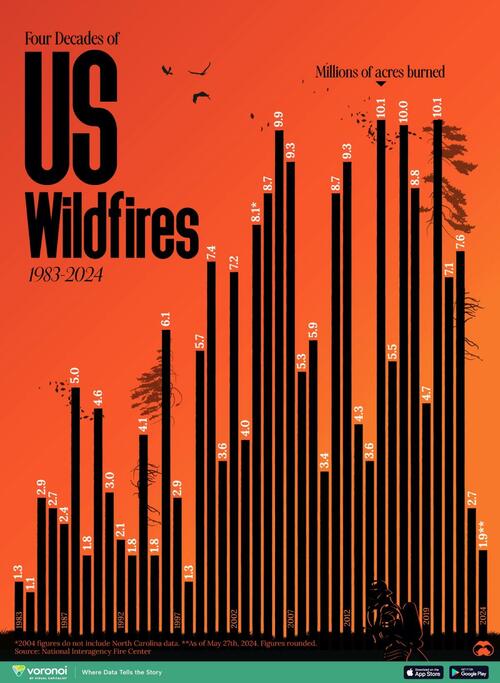Visualizing Four Decades Of US Wildfires
A complex interplay of factors are leading to North America’s long wildfire season: increasing summer temperatures, erratic precipitation patterns, changing land use, and ironically, fire suppression practices.
But what does the data say? Visual Capitalist's Pallavi Rao visualizes the millions of acres burned by U.S. wildfires from 1983 to May 2024, per statistics from the National Interagency Fire Center.
2010 and 2015 Saw Record Land Burned by Wildfires
From glancing at the chart, it’s apparent that U.S. wildfires are burning significantly more acres on average in the 2010s than they did in the 1980s. Interestingly, the World Economic Forum points out that while the number of fires itself has fallen since 2005, the land burned has increased, indicating wildfire intensity has grown.
| Year | Million Acres Burned |
|---|---|
| 1983 | 1.3 |
| 1984 | 1.1 |
| 1985 | 2.9 |
| 1986 | 2.7 |
| 1987 | 2.4 |
| 1988 | 5.0 |
| 1989 | 1.8 |
| 1990 | 4.6 |
| 1991 | 3.0 |
| 1992 | 2.1 |
| 1993 | 1.8 |
| 1994 | 4.1 |
| 1995 | 1.8 |
| 1996 | 6.1 |
| 1997 | 2.9 |
| 1998 | 1.3 |
| 1999 | 5.7 |
| 2000 | 7.4 |
| 2001 | 3.6 |
| 2002 | 7.2 |
| 2003 | 4.0 |
| 2004* | 8.1 |
| 2005 | 8.7 |
| 2006 | 9.9 |
| 2007 | 9.3 |
| 2008 | 5.3 |
| 2009 | 5.9 |
| 2010 | 3.4 |
| 2011 | 8.7 |
| 2012 | 9.3 |
| 2013 | 4.3 |
| 2014 | 3.6 |
| 2015 | 10.1 |
| 2016 | 5.5 |
| 2017 | 10.0 |
| 2018 | 8.8 |
| 2019 | 4.7 |
| 2020 | 10.1 |
| 2021 | 7.1 |
| 2022 | 7.6 |
| 2023 | 2.7 |
| 2024** | 1.9 |
*Doesn’t include North Carolina data. **As of May 27, 2024.
In 2015, wildfires burned more than 10 million acres in the country, a first since these records began. Five years later saw a repeat, thanks to four Californian fires that together burned more than 2.3 million acres in the state.
For comparison, U.S. wildfires burned approximately 2.7 million acres in total in 2023, the lowest amount recorded since 1998. An unusually wet Californian summer helped prevent errant sparks from turning into raging disasters.
Nevertheless, in August, a devastating fire nearly wiped out the historic town of Lahaina, Maui, killing at least 100 people.
Finally, U.S. wildfires have burned 1.9 million acres in 2024 so far, currently below the 10-year annual average of 7.2 million acres. However, experts predict a hotter-than-usual summer and autumn, and fire activity is expected to increase as the summer progresses.



